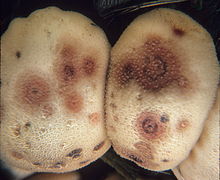Epicocconon
| Structural formula | |||||||||||||
|---|---|---|---|---|---|---|---|---|---|---|---|---|---|

|
|||||||||||||
| General | |||||||||||||
| Surname | Epicocconon | ||||||||||||
| other names |
|
||||||||||||
| Molecular formula | C 23 H 22 O 7 | ||||||||||||
| External identifiers / databases | |||||||||||||
|
|||||||||||||
| properties | |||||||||||||
| Molar mass | 410.42 g mol −1 | ||||||||||||
| safety instructions | |||||||||||||
|
|||||||||||||
| As far as possible and customary, SI units are used. Unless otherwise noted, the data given apply to standard conditions . | |||||||||||||
Epicocconon is a fluorescent dye from the fungus Epicoccum nigrum .
Properties and use
The water-soluble epicocconone fluoresces slightly greenish (λ em = 520 nm) in its protonated form, after binding a protein the maximum fluorescence shifts to a wavelength of 605 nm. The absorption maximum is 395 nm. When adding base , a proton is given off. However, the resulting anion loses the ability to fluoresce:
The dye can react with primary amines. This is used in biochemistry in the context of protein characterization in order to stain proteins , in particular when determining the quantity in solutions, for tracking proteolysis , in SDS-PAGE , in 2D gel electrophoresis with in-gel digestion and mass spectrometric analysis, and as Loading control for Western blots ( detection limit 1 ng after 40 minutes). The staining is reversible and compatible with immunostaining or mass spectrometry . An intense, red-fluorescent enamine forms during the reaction . However, if the proteins are in a too basic environment, the enamine product is deprotonated and loses its fluorescent properties.
Synthetic variant
In addition to the natural variant from the mushroom, the dye now also exists as a synthetic product. Regarding the coloring properties of proteins, there are no differences between the natural and synthetic variants.
Web links
- fluorophores.tugraz.at: Epicocconone
Individual evidence
- ↑ interchim.fr: product sheet (PDF; 370 kB), accessed on December 29, 2012.
- ↑ This substance has either not yet been classified with regard to its hazardousness or a reliable and citable source has not yet been found.
- ^ PJ Bell, P. Karuso: Epicocconone, a novel fluorescent compound from the fungus epicoccumnigrum. In: Journal of the American Chemical Society. Volume 125, Number 31, August 2003, pp. 9304-9305, doi : 10.1021 / ja035496 + , PMID 12889954 .
- ↑ JA Mackintosh, DA Veal, P. Karuso: Fluoroprofile, a fluorescence-based assay for rapid and sensitive quantitation of proteins in solution. In: Proteomics. Volume 5, Number 18, December 2005, pp. 4673-4677, doi: 10.1002 / pmic.200500095 , PMID 16267819 .
- ↑ JA Mackintosh, HY Choi, SH Bae, DA Veal, PJ Bell, BC Ferrari, DD Van Dyk, NM Verrills, YK Paik, P. Karuso: A fluorescent natural product for ultra sensitive detection of proteins in one-dimensional and two- dimensional gel electrophoresis. In: Proteomics. Volume 3, Number 12, December 2003, pp. 2273-2288, doi: 10.1002 / pmic.200300578 , PMID 14673778 .
- ↑ JA Mackintosh, DA Veal, P. Karuso: Fluoroprofile, a fluorescence-based assay for rapid and sensitive quantitation of proteins in solution. In: Proteomics. Volume 5, Number 18, December 2005, pp. 4673-4677, doi: 10.1002 / pmic.200500095 , PMID 16267819 .
- ↑ P. Karuso, AS Crawford, DA Veal, GB Scott, HY Choi: Real-time fluorescence monitoring of tryptic digestion in proteomics. In: Journal of proteome research. Volume 7, Number 1, January 2008, pp. 361-366, doi: 10.1021 / pr0704480 , PMID 18052032 .
- ↑ a b Hubert Rehm , Thomas Letzel: The experimenter: protein biochemistry / proteomics . 6th edition, Spektrum Akademischer Verlag, Heidelberg 2009. ISBN 978-3-8274-2312-2 . Pp. 18, 28.
- ↑ DR Coghlan, JA Mackintosh, P. Karuso: Mechanism of reversible fluorescent staining of protein with epicocconone. In: Organic letters. Volume 7, Number 12, June 2005, pp. 2401-2404, doi: 10.1021 / ol050665b , PMID 15932208 .
- ↑ NS Tannu, G. Sanchez-Brambila, P. Kirby, TM Andacht: Effect of staining reagent on peptide mass fingerprinting from in-gel trypsin digestions: a comparison of SyproRuby and DeepPurple. In: Electrophoresis. Volume 27, Number 15, August 2006, pp. 3136-3143, doi: 10.1002 / elps.200500740 PMID 16800026 .
- ↑ a b C. P. Moritz, SX Marz, R. Reiss, T. Schulenborg, E. Friauf: Epicocconone staining: a powerful loading control for Western blots. In: Proteomics , Volume 14, Number 1-2, February 2014, pp 162-168, doi: 10.1002 / pmic.201300089 PMID 24339236 .
- ↑ DR Coghlan et al. : Mechanism of reversible fluorescent staining of protein with epicocconone . In: Org Lett. 7, No. 12, 2005, pp. 2401-2404, PMID 15932208 .
- ^ A. Boulange, PA Peixoto, X. Franck: Diastereoselective IBX oxidative dearomatization of phenols by remote induction: towards the epicocconone core framework. In: Chemistry. Volume 17, number 37, September 2011, pp. 10241-10245, doi: 10.1002 / chem . 201101681 PMID 21809405 .


